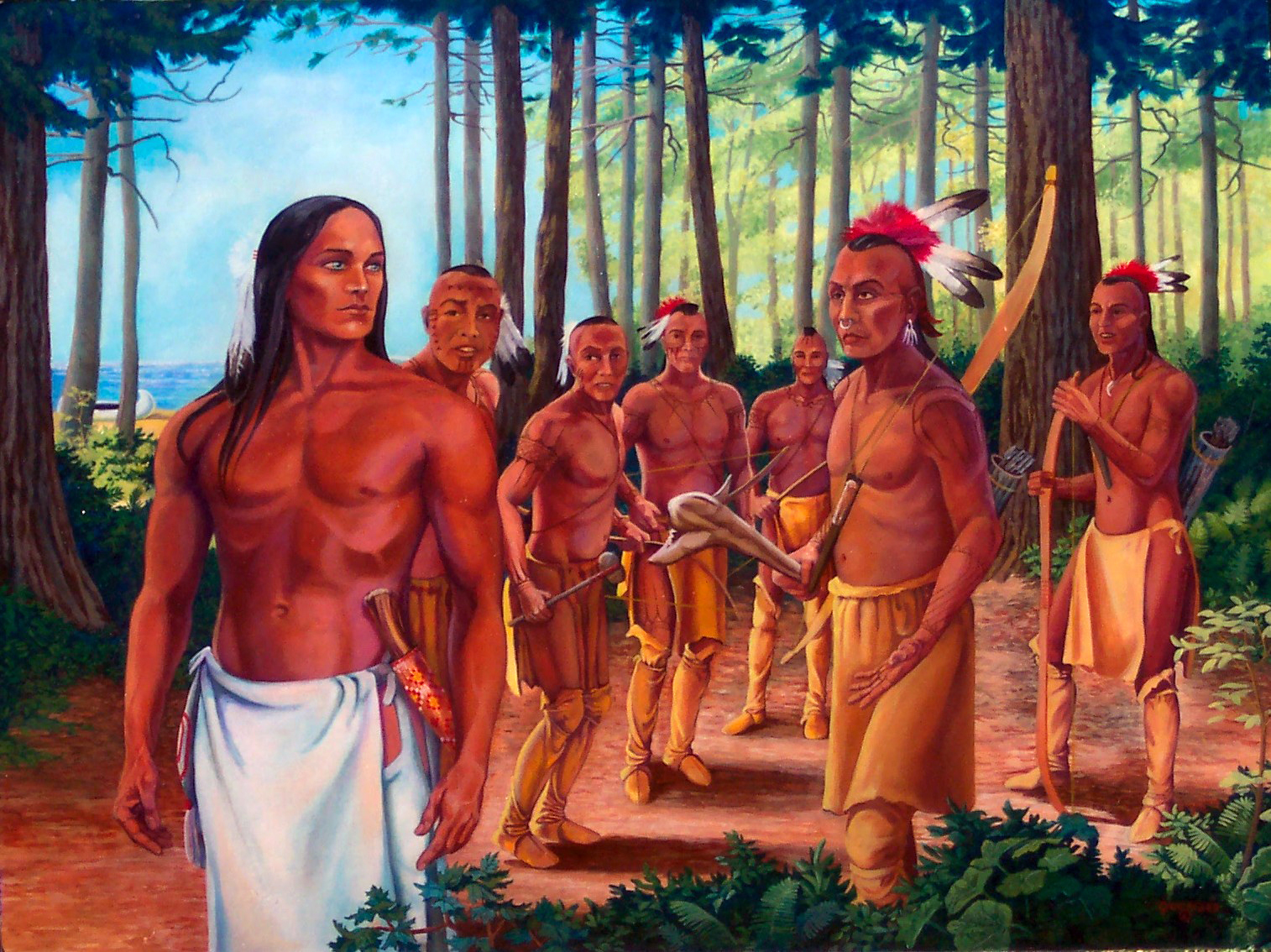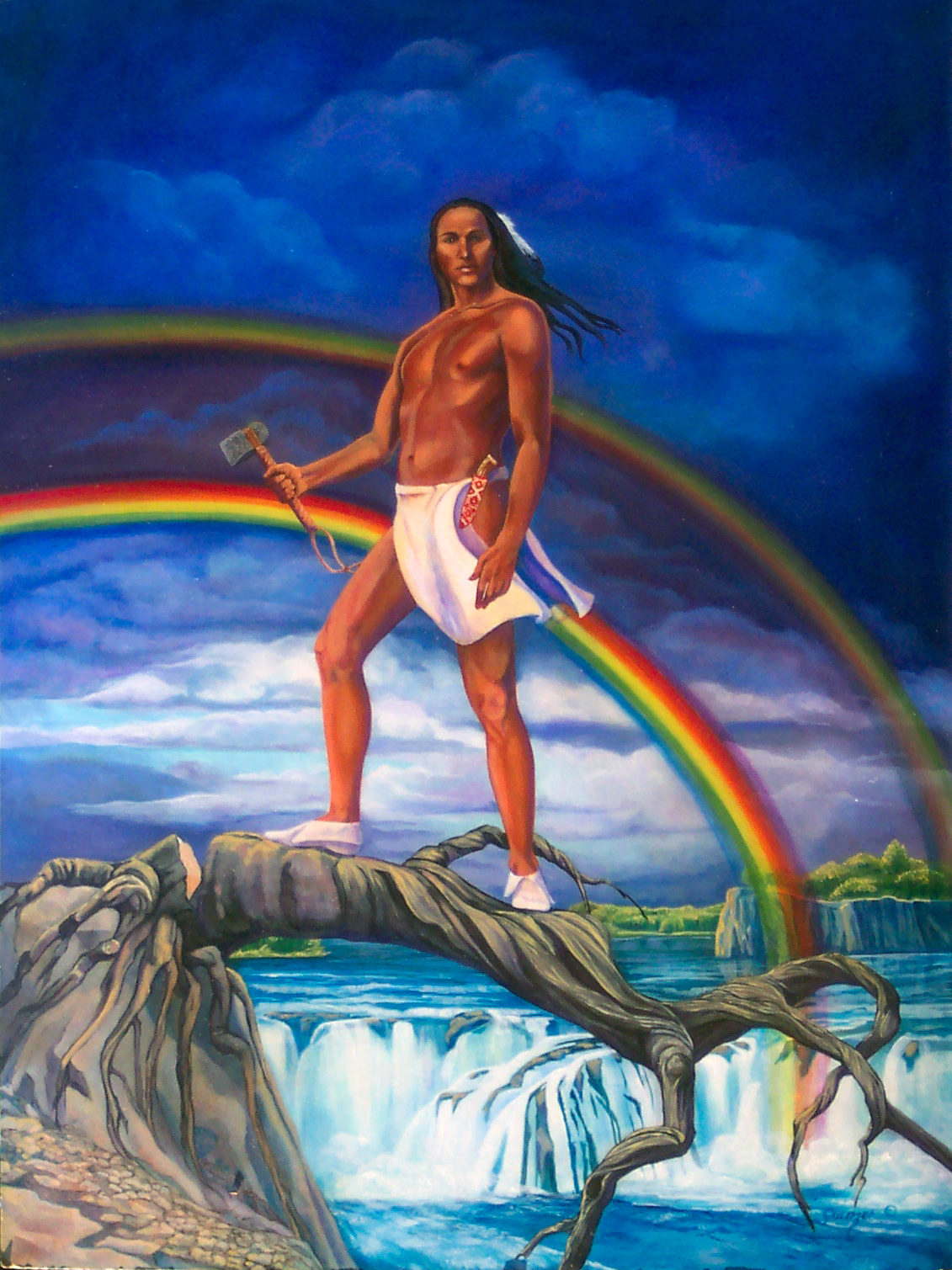STORIES ON THIS PAGE
THE PEACEMAKER IS BORN
THE PEACEMAKER WITH HIS FRIENDS
ARRIVAL IN THE WHITE STONE CANOE
PEACEMAKER FINDS SOME MOHAWKS
PEACEMAKER VISITS THE MOHAWK VILLAGE
THE TREE OF WAR
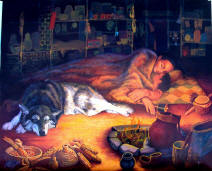
When the Creator made the human beings, everything needed to survive in the future was created. The People were told to never forget to be appreciative of the gifts of Mother Earth and to care for one another. The people were instructed how to be grateful and how to survive.
The People of Turtle Island grew and multiplied until they numbered a great many nations. These peoples began to feud and fight among each other. This made a dark age in Onkwehoweh (Real People) history as the human beings no longer listened to the original instructions.
The people lived in a condition of perpetual war throughout their homelands. The wars became so bad that the people’s hearts were constantly on the ground. They were always burying a child, a son, a father, a brother, an uncle, or some loved one. The people lived in a state of fear so overwhelming, they refused to leave their palisaded villages without a heavy guard. Frequent raids and ambushes in the nearby forests prevented the men from hunting, resulting in wide spread starvation. The people were fearful of leaving their homes at night. They did not trust even their neighbors for a cannibal cult had arisen and many people just disappeared. Many people abandoned their homes with some seeking refuge among neighboring northern tribes. So great was their distrust and so entangled in their wars, that even if the people wanted peace, none could see how it could be achieved, for if one among them were to clamor for peace, they would be taunted as traitor and dishonored. The people were at an impasse, prisoners of their own ways, stuck in the perpetual cycle of war and hate.
The Creator looked upon the world and what was going on. The Creator was sad because there was so much wickedness, deceit, injustice, murder, and so many wars. He was sad, for he did not create mankind to kill and murder one another. It was time to remind the people of the Original Instructions once again.
So he found in the Northern country, in the Wendot settlement of Takahaanaye on the north shore of Lake Ontario, where there was a destitute woman living alone with her young daughter. They had no family, no clan was apparent, perhaps having been killed in the wars. So it came as quite a surprise when the daughter showed that her life was changing and it became apparent she was with child. When her mother asked her daughter who was the father of her child, the young woman insisted she did not know as she had never been with a man. Having no father placed great hardships on this mother-to-be, for the grandmother was most harsh with her, demanding to know of the baby’s father. Many times, his mother shed tears because of the harshness of the grandmother.
Then one night, The Creator gave the old woman a dream. The Creator told her the baby was a special emissary to the people. The Creator said the baby should be named Dekaniwida, which was to mean “Master of All Things”. The child had an important work to do for humankind as the Creator did not intend for man to kill one another. So the Creator had sent this unique messenger to be born of a Huron Virgin. The Creator’s emissary came into this world to teach the path of peace to all who would hear it. He was sent by the Creator on this extraordinary assignment, to stop the war and killing, and to bring peace to the people. The Old woman was instructed to raise him up in a good way, and when it came time for him to leave, that the two women should not try to stop him but help him. They were also told that one day he would inadvertently be responsible for the destruction of his own people, the Huron.
Because of this prophecy, the grandmother decided that the baby must be done away with to protect her people. So shortly after the baby was born, she took the baby from his sleeping mother’s arms, and went out into the cold winter night, across the snow to the frozen river and with a heavy heart, she cut a hole in the ice. She then threw the baby into the icy freezing water. Thinking she was done with this, she made her way through the black freezing night, trudging through the snow back to her lodge where she stoked the lodge fire, and crawled under her fur robes. But in the morning the child was wrapped warmly snuggled in his mother’s arms, fast asleep.
Shocked, the Grandmother wondered what she must do. All day she wondered but she decided she must throw the baby in the icy river again. So that night, she took the baby again from his sleeping mother’s arms, and she took him out into the frozen winter night. When she reached the ice-covered river she again cut a hole in the ice and threw the baby into the icy waters.
And the next morning there the child was warmly snuggled against the mother. The Grandmother realized that this was highly unusual. But gradually, she worried again about her people. It was true that here she lived alone only with her daughter and not this infant. But the village was kind, and they made sure that she had meat from the hunts and she shared duties with the other women in the fields so that she may have a share of the crop. The more she thought about it, the more she decided to try again to get rid of the infant child.
So as the night grew long, she again took the infant child from his sleeping mother's arms and went out into the cold night. She thought that if the same thing happened again that would be the end of her efforts. She would then know that this child truly was sent by the Creator. When she reached the river, she cut a hole in the ice and threw the baby into the freezing water.
In the morning, the child once again lay warmly snuggled against his mother’s breast. Now the grandmother thought that this child was indeed extraordinary. She thought this showed the child possessed some magical orenda and that he truly was sent by the Creator with special protection. After that, the grandmother was good to the daughter, and loved her grandson very much. She tried to raise him up in a good way.
THE PEACEMAKER WITH HIS FRIENDS
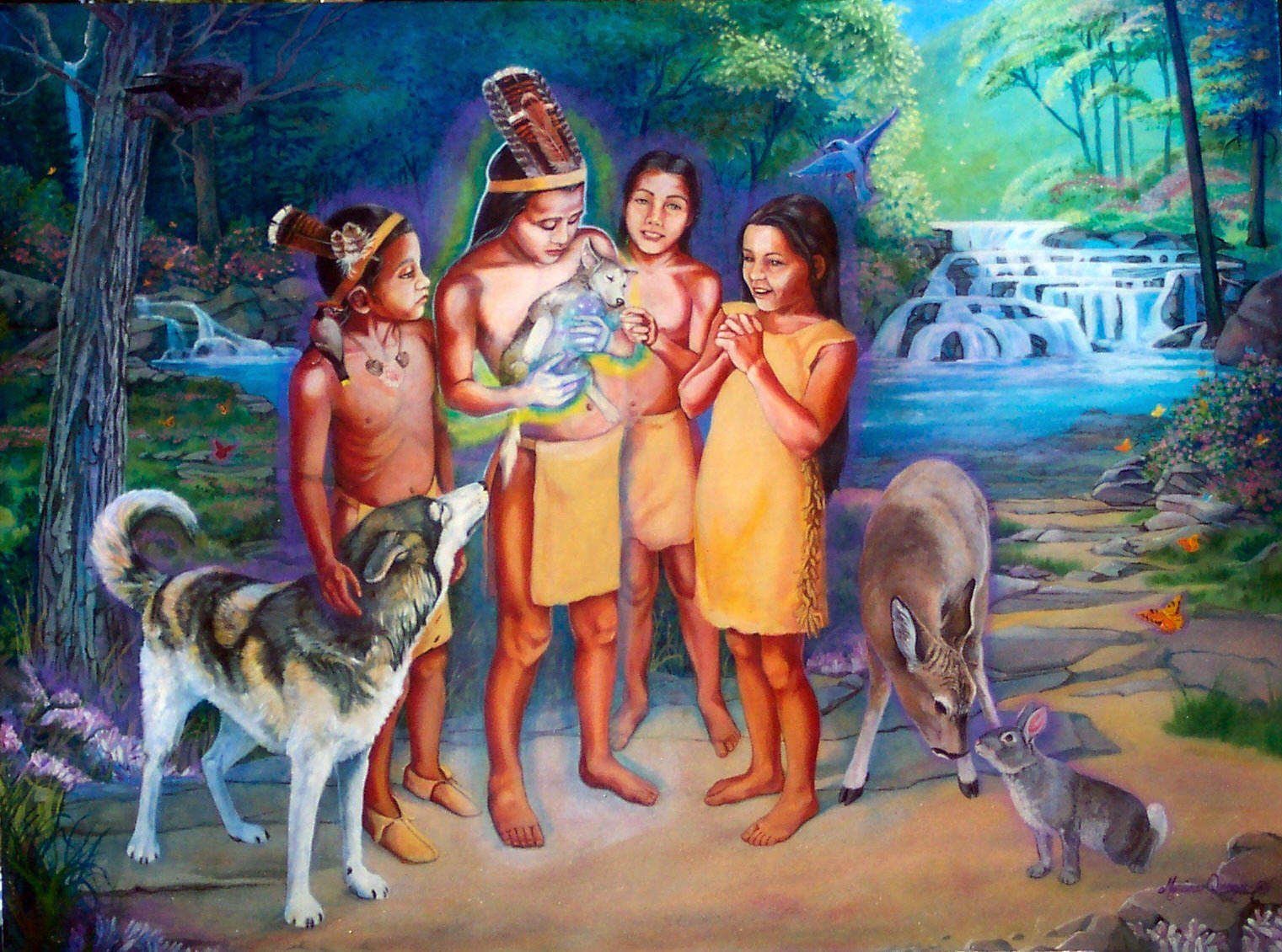
From earliest childhood, the fatherless child was remarkable. He was truthful, good, enormously intelligent, generous, and splendid looking. Animals loved him and he seemed to enjoy rare powers of communication with them. He whistled to birds and they came and sat on his shoulder. He conversed with fireflies in the night and the morning saw him in communion with a bear. Rabbits came out of their burrows to be with him, and snakes swayed in front of him imparting their earthy wisdom.
The war-like Huron peoples found the boy strange, and when he began to talk of peace, they saw him as foolish. While other Wendat boys played at war to sharpen the skills they would need later in life, the Fatherless Child talked to the earthly forces about him. And he talked of peace, friendship and unity. Conversely he departed from the Huron ways a young man should go, not participating in these games of war and hunting. He simply did not understand the quarreling and contention displayed over misunderstandings and disagreements.
This handsome young man was always completely honest and always spoke with a straight tongue. He tried to show the people a better way to settle their differences. He tried to teach them to love one another, to be kind and considerate, to take care of the widows and the children, to respect the old people. He tried to teach them to be true to their word.
He wanted to teach the people to be careful of the Mother Earth, to walk softly upon her, and in all things to consider to protect her for the seventh generation so children yet unborn will have a beautiful place to live with the abundance to live upon. He tried to instruct the people to care for the animals, and to appreciate their sacrifice when they gave up their lives for the people to have food. And he tried to teach the people to have gratitude for the plants that healed and provided food for the people’s use and to not misuse their medicine properties.
He continued to talk of a new society based on peace and friendship but he frequently offered advice to the others on improving their lives and on the governing of the tribe. But this kind of honesty while he was yet very young, went unappreciated by his elders. He also declared to all who would listen that his message had been inspired directly by the Great Spirit and that he himself was the messenger of the Master of Life. This REALLY did not set very well with the Elders and leaders of the village.
In this ancient time, there were 12 other infant boys who had been born to the parents in the village. Since they were the same age as the Fatherless Boy, it was that they should become friends. At once the people noticed unusual events when the fatherless child was involved. The mothers of these sons decided each on their own to visit the Mother of the fatherless child. When they arrived, they all arrived at the same time as though by some previous agreement. This happened again and again as if their visits were planned.
On one of these visits, one of the mothers wondered just what the boys were doing so she stole away from the other women and went through the forest until she could hear the boys. As she peered through the bushes she realized that the fatherless boy was teaching their sons ceremonies. The first was the Great Feather Dance (Ostoeahgo;wa}. The second was the Drum Dance (Ganeho;). The third and final was the Personal Male Songs (Ado;wa). When the fatherless boy asked for someone to step forward to practice the songs, the boy who stepped forward performed it as though he had known it for years. He could do this because he had the help of the unusual child. The Fatherless Boy also taught the boys the Thanksgiving Address and the Peach Seed Game. These 12 boys practiced the ceremonies and continued in this way until they were old.
As the boys grew up, they would get a feeling to go see the fatherless boy. When they would arrive, they would see that each one had the same idea and they would meet together. Then one day as they met together as usual, the grown young man announced that he had to leave to go to a faraway country to teach the people there about Peace and Love, and his Good Message for the Good Mind. He left behind 12 young men that he had taught his way of Peace and the Good Mind. He walked down the trail and disappeared from the young men’s sight behind a large white pine tree.
THE PEACEMAKER'S ARRIVAL IN THE STONE WHITE CANOE
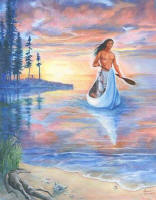
The boy-man now addressed his mother and grandmother. He said that it was now time for him to begin his journey but that he first must prepare himself. His Grandmother helped prepare his purification and after the ritual, he left the settlement and wandered deep into the forest alone, seeking clarity and spiritual insight. As is the way of such quests, he fasted and prayed, allowing himself only an occasional sip of water and focusing his attention on what he should do and where he should go.
“Great Spirit,” He prayed over and over again, “show me what it is that you wish me to do among the nations. Show me the plan of my mission.”
After many days, his mind opened and altered by fasting and prayer, a vision came to him. He saw clearly the extraordinary work he was to do in the world, the work of going from person to person and from tribe to tribe persuading them to lay down their war instruments and to take hold of the ways of peace and the New Mind. A plan was formulated, and the symbols representing the unity of the people were given. He saw many things that would guide him in accomplishing his mission.
Upon receiving the information he sought, he returned to the village and to his mother and grandmother, He addressed them with great affection saying, “The time has come for me to set out on my mission in the world. I shall now build my canoe. Know that far away, on lakes and many rivers, I go seeking the council smoke of nations beyond this lake, holding my course to the sunrise. It is my business to stop the shedding of blood among human beings.”
He then set about to make a craft to carry him over the great water. Again he disappeared into the forest and after some time, he had carved his canoe from white stone. Now he went to his mother and grandmother for help to push the canoe to the water. When the grandmother first saw the canoe was made of stone, she was dismayed. She said, “But the canoe is made of stone, you foolish boy. “It will not float. It will sink like a rock.”
“It will float,” insisted the young man undaunted. “This shall be a sign that my words are true. And by this impossible action, you shall know that my words are true, and that I shall bring peace to the nations.”
Thus with the help of his mother and grandmother, they brought the white stone canoe to the water where he bade them farewell. It was hard for them to see him leave his homeland and travel to an unknown country and people who were fierce but they remembered the instruction to not hold him back but to help him and so they prepared bundles for his journey and gave him leave from their home.
“Do not look for my return,” he said, “for I shall not come again this way. Should you wish to know if all is well with me, go to the hilltop yonder where stands a single tree. Cut at the tree with your hatchets, and, if blood flows from the wound, you will know that I have perished and my work has failed. But if no blood flows, all is well, my mission is successful.”
Farewells and messages delivered, they pushed the canoe into the water, where he entered it, and paddled it swiftly away. It moved rapidly out on to Lake Ontario as though by some unseen power swiftly it was out of sight. The sunlight glinting off the white stone as though a bright spot dancing upon the water. The Fatherless man now left his homeland for uncertain destinations. But now armed with his vision and at the urging of spirit, he now was full of faith that he should be the deliverer of a new social order among the warlike nations.
Many would be the perils he would face and overcome. In such time, if his life should be in peril, he now had assurances of success, and if at any time, he was fearful, he always had the right words and actions to impart to the fierce peoples he would encounter. So steadfastly did he stick to his cause, and his goals, that eventually, the lives of the people would be changed for generations, governments would rise and fall according to his teachings, and prosperity would be attained by all those who would take hold of the message that he brought.
Over time, the fatherless boy’s name would become sacred among the people and spoke only in ceremony, and he would be known by many only as “The Peacemaker.”
THE PEACEMAKER FINDS SOME MOHAWKS
The Peacemaker began his journey in his white stone canoe. Upon crossing Lake Ontario known at that time as the Beautiful Great Lake, he scanned the shoreline for signs of a settlement. Here he saw nothing for the times were evil and the settlements were set back among the hills for protection. He saw no villages and signs of people.
Finally as the Peacemaker neared a point of land, he saw the figures of men running along the shore. They had seen the sparkle of the sun and water reflecting on the white canoe and wondered what it might be. They were gathered together and excitedly motioning to others still gathering and then back pointing to the water. The Peacemaker having seen the men also turned toward the shore and swiftly landed ashore. It is said that the canoe traveled as if of some magic for it could move so swiftly upon the water.
Having reached the shore, the Peacemaker now climbed from his canoe and stood before the men. The Peacemaker having been raised by his grandmother and his virgin mother who had no other relations and therefore had no allegiance to any nation or clan and having no purpose other than Peace, looked and dressed different than these men. This too made these men curious as to whom he might be.
As the Peacemaker looked around, he saw no signs of a village and so he asked the men, “What purpose has brought you to this desolate area?”
“We are the People of the Flint. We are hunters,” came the reply. “We have come a long way from our lodges to hunt because of the strife there. The people are hungry but they do not trust one another. There is much bloodshed and deceit. The people do not know who are friend and who is the enemy and so we have to travel great distances to find safe hunting for food.
“Go back to your people”, said the Peacemaker, “Tell your chief that the Good News of Peace and Power has come, and that there will be no more strife in his village.” The Peacemaker continued, “This warfare that is going on is not the way the Creator wanted it for people to be on the earth; to be against one another. He gave you people love and also peace on earth that you should live on earth happily. That’s what he sends you down here on earth for. If your chief asks whence Peace is to come, say to him, ‘It will come' “.
“Who are you that you can say this will be so?” asked the hunters unbelievingly. Such claims surprised them. No one knew how to stop the bloodshed and fighting but the people were tired and would welcome anyone who could bring about a peace…. But they did not believe it to be possible.
“I am sent by the Maker of Men to bring Peace to all thinking men. I come from the north and I go toward the sunrise.” The Peacemaker told them in time he would come to the village and that they should keep watch for him. Then the Peacemaker got ready to leave, the hunters saw that the canoe was made of stone and so they believed what the Peacemaker had told them.
The hunters returned to their village. As the Peacemaker had told them to do, they went to their chief and said to him. “The Good News of Peace and Power has come.”
“What is this you are saying?” asked the chief.
“There will be no more strife in the village,” the hunters repeated.
“Who told you this?” inquired the chief.
“A man in a white stone canoe that seemed to fly across the water,” the men excitedly replied.
“Where did you see such a thing?” skeptically asked the chief.
“On the Beautiful Great Lake. He came from the west and he goes toward the sunrise,” continued the hunters in agreement, and they began to describe the encounter with the strange personage recounting the first sighting of flashing light upon the water to the strangely attired young man who disembarked from the craft.
Then the chief began to wonder at the news. His town was at war, and his people within the stockades were hungry and quarreling among themselves. “When can this Peace come?” He asked.
They replied, “It will come.”
Then the chief said, “This truly is a wonderful thing" if it be so. Such news of itself will bring peace to the settlement if once men believe it. All will be glad and at relieved in their minds to know that this thing will be.”
VISIT TO THE MOHAWKS
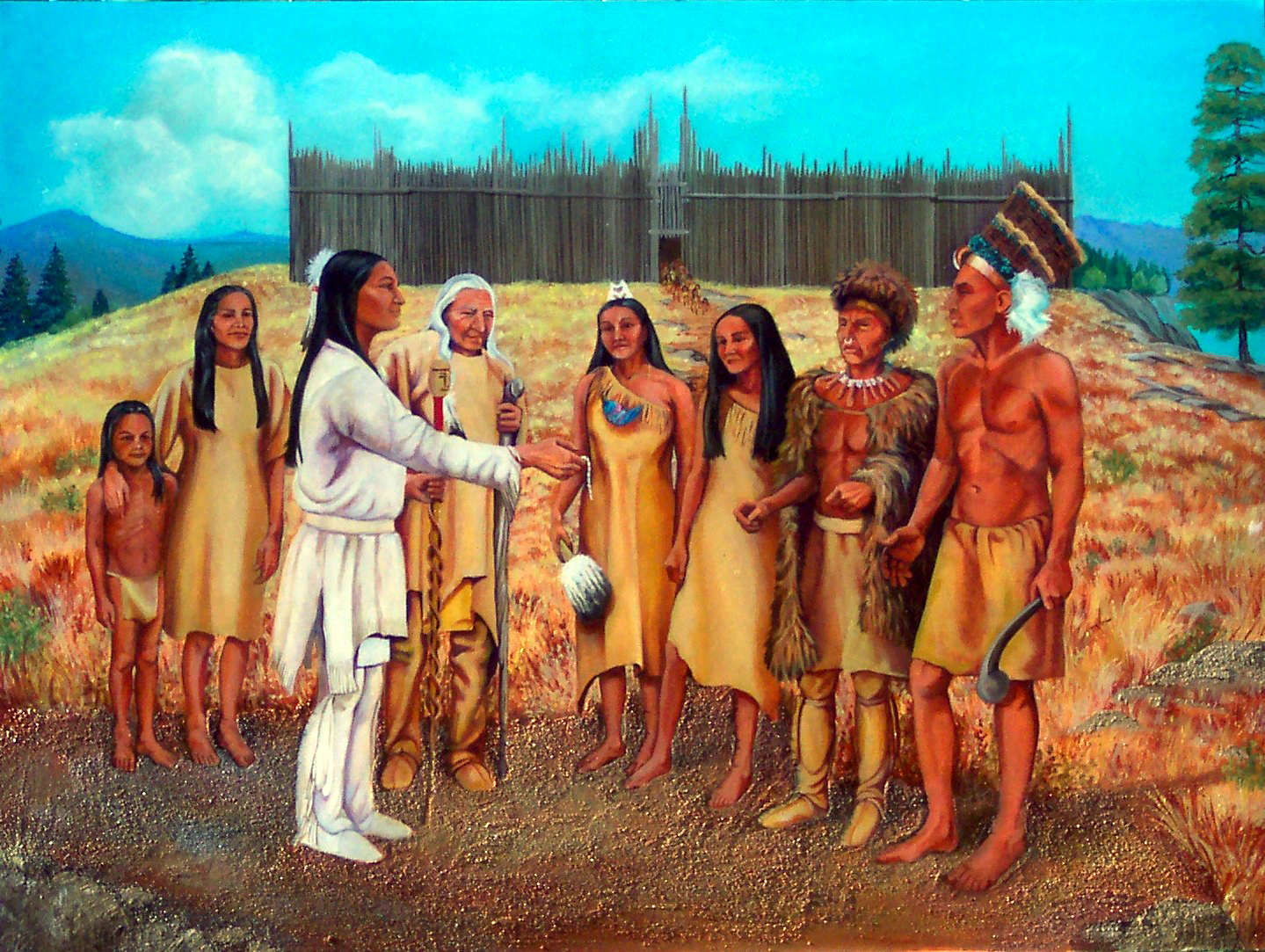
The Peacemaker now took course toward the rising sun, toward the land of the Flint Nation or Mohawks. Near the lower falls of the Kanienga River, The Peacemaker made camp. Here in the evening he sat beneath a tall tree while cooking something to eat. A Mohawk man passing by saw him and inquired, “Who are you?”
“I am sent by the Great Creator from whom we are all descended to establish the Great Peace among you.”
“There is no Peace here!” said the man, “But I will take you to my village and you can explain this message to the People.” So the Peacemaker presented the Good news of Peace and Power to the Mohawks and the People were glad for they had found it a good message. But the chiefs were cautious and held back.
The Chief Warrior said to the Peacemaker, “You speak well. Reason and Law and Peace are good things. But we are surrounded by our enemies so how can this Peace some?”
“It will come,” said the Peacemaker, “with the Words of the Law.”
Then the Chief Warrior said to the People, “What this man says is good but is it true? He is a stranger here. Why should we believe him? This could be a trap. If we lay down our arms, our enemies will jump upon us and slay us. We must have a sign that what we are being told is so.”
The sign the Mohawk sought was for the Peacemaker to climb to a high place in a tree where they might chop it down into a chasm and if he should survive, then they would know his words were true.
The Peacemaker saw a twisted and dying tree that had grown out over a chasm. Here he sprung upon the end of this tree in precarious balance. Here the Peacemaker spoke with authority, exclaiming that the People wanted Peace but their actions created enemies from their fear. He came in Peace and was greeted with suspicion and fear.
“Look,” the Peacemaker said as he pointed to the ground where the tree trunk writhed out of the earth. “I can see your hatred and your fear. Can you see it too, crackling through the air?” At the very moment the storm clouds, which for some time had been gathering overhead, suddenly exploded. As a deafening roar of thunder shook the twisted tree beneath him, a crackling fork of jagged lightning danced ominously upon the very ground at which he pointed.
“Look,” the Peacemaker repeated as the crowd stood stunned. “I will show you your hatred. It flows from the group of you standing there up the trunk of this misshapen tree and fragments, like these dying twisted branches, then into numerous twigs and brittle forks.”
“The idea you live with, that warfare is necessary, is a lie that you believe in. It is misshapen and as precariously rooted as this dying tree that hangs suspended over this gorge. Your belief in warfare as a way of life not only divides you from other tribes as the branches of a twisted tree divide from the trunk, but it also divides you from your families, from your own hearth fires, from all the things you love the most. And every day you go forth to fight you know this is true.”
“Do you increase your security with this monstrous lie? No!! You know this is true. This lie you believe is like this dying tree, a tree that offers no comfort, no fuel, no shade, a tree that saps the strength and twists the values of all those who become entangled in its many devious branches. “
“I am not a Mohawk. But neither am I the enemy you imagine. I come from the tribe of Real People. I am Ongwehowhe. I represent the Maker of Men and I now implore you to move your village under the great boughs of the living Tree of Peace. Men of the Mohawk Nation, if you care for truth then cut this tree of violence from your hearts”.
There was a rumble of agreement from the gathered village. And then the Chief Warrior said, “We will indeed cut this tree away. And you with it. If you shall survive then we shall learn more of your truth.”
THE TREE OF WAR
The Peacemaker took his own hatchet, raising it high to the darkening sky above, he cried out. At that moment the sky seemed to open and the rain began to pour down.
Then the Peacemaker shouted above the fury of the wind driven rain, “It is I who have said the twisted Tree of War must be cut from your lives. It is I who will cut away this tree and fall with it. My act will give you a teaching that my words have not. No man should ever be afraid to cut falsehood from his life even if it is the thing upon which he is standing.” With savage fury the Peacemaker began to hack away at the twisted Tree of War until a few more blows would sever it completely. As he looked up from his work, he saw in their faces a different expression, that of respect and understanding.
At that moment the Peacemaker stood, the sun broke through the clouds and a rainbow appeared in an arch of brilliance across the valley below. He spoke. “There is no place for violence in the heart that honors the teachings of the Great Spirit. Remove such error from your hearts as I now remove this tree from its false roots.” With that he leapt into the air and landed fully upon the overhanging mass. There was a tremendous crack as the old tree broke loose from the cliff and tumbled into the ravine below with the Peacemaker.
The People waited for their sign. But there was no sight of the Peacemaker. They looked down into the ravine but could not see him. They waited but there was no sign. “Let us return at sunrise,” said the Chief Warrior ant the People went back to their village for the night.
The next morning a man was sent from the village to the place where the tree had fallen into the gorge. On the path to the village, he saw a column of smoke rising and thought that he should go to see what it was about. When he arrived, he saw the Peacemaker sitting beside his fire with a deer he had brought to share with the Mohawks. He returned to the village and told what he had seen. So now the People came out and brought the Peacemaker into the council house.
The Chief Warrior spoke, “Yesterday, “he said, “I was in great doubt, but now I am in doubt no longer. This is a great man who reveals to us the Mind of the Master of Life. Let us accept his message. Let us take hold of the Good News of Peace and Power. “
Then the Peacemaker said, “The day is early and young and so also is the New Mind. And as the new sun rises and proceeds surely on its course in the sky, so shall the young mind prevail and prosper among men. There shall be Peace.”
Thus the Mohawks were the first nation to take hold of the Great Peace. They were the founders of the League. As they had taken in Hayenwentha and were eager to follow him into Peace until sorcery had ended Hayenwentha’s mind. They now readily adopted the Peacemaker that he may reside with them. The People had suffered greatly during these dark times and now they anticipated the Peace that this stranger had promised.
The Peacemaker lived among them and taught them the ways of Peace and the Good Mind. He taught them to reason and not argue. He taught these Mohawks, the People of Flint, to be just, and to adhere to the principles of the Great Laws.
Now with the restoration of Hayenwentha to sense and reason, the Peacemaker and Hayenwentha, encouraged, exhorted, and extolled the benefits derived from Peace, and together they led the Mohawks into a new understanding of love, and abundance. It was not easy, for witchcraft and evil abounded but the People really wanted Peace and so with the unifying of the New Mind among the People, those who practiced evil gave way their old practices and became staunch supporters of the new social order.

